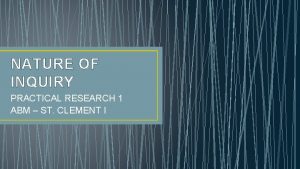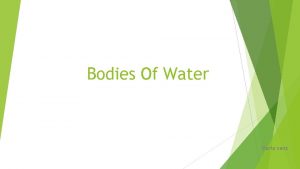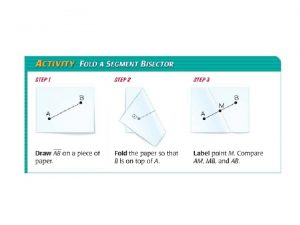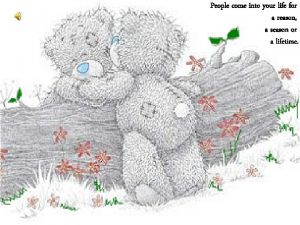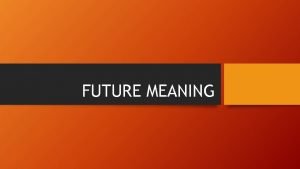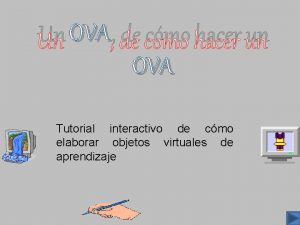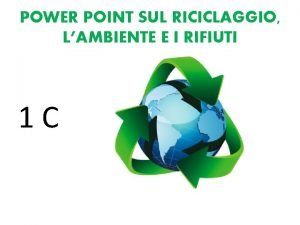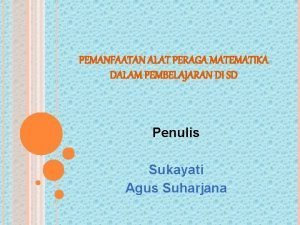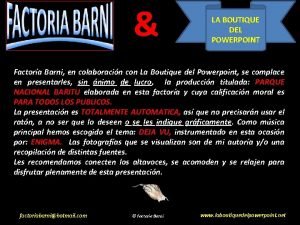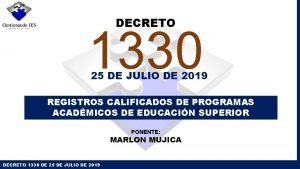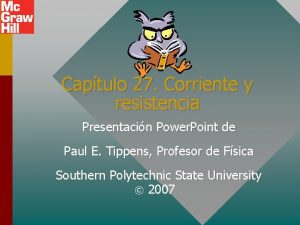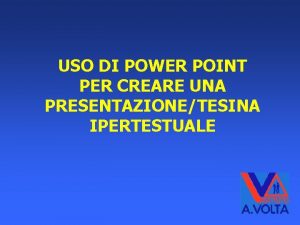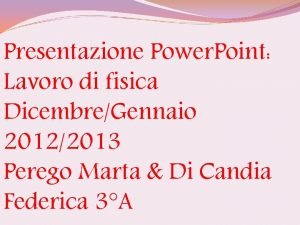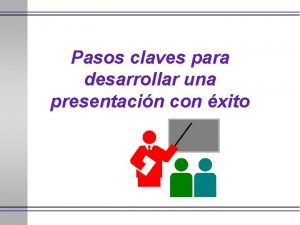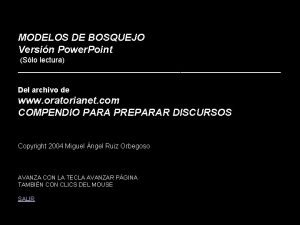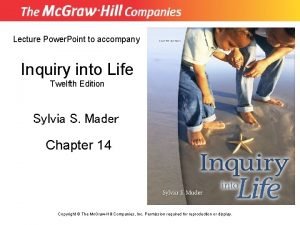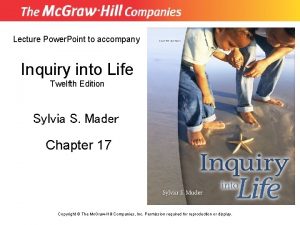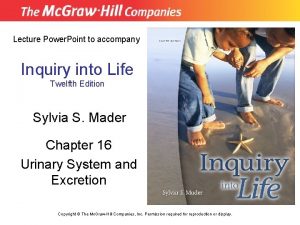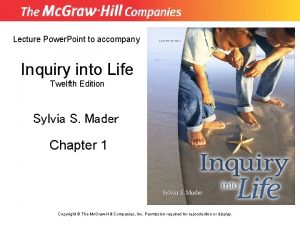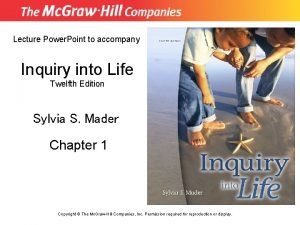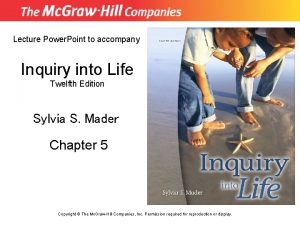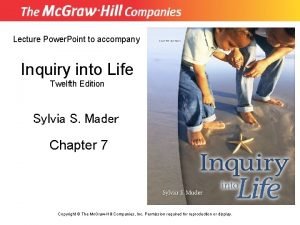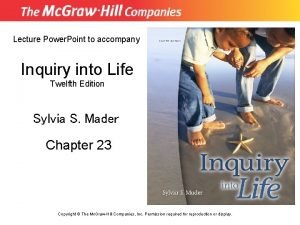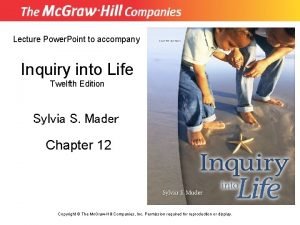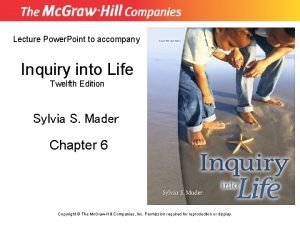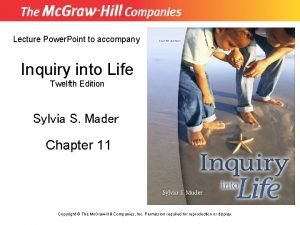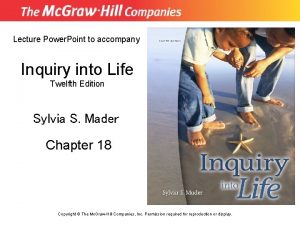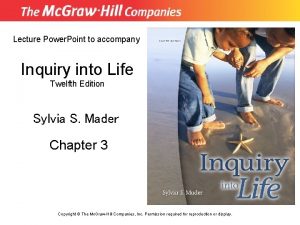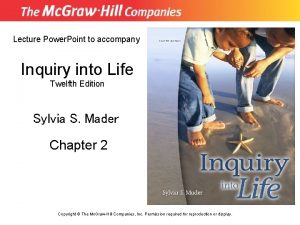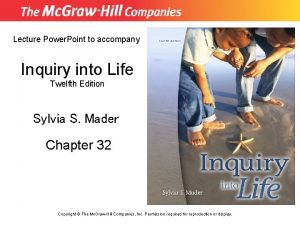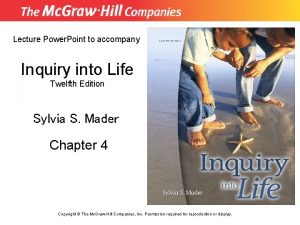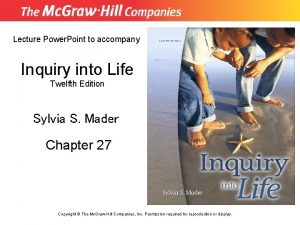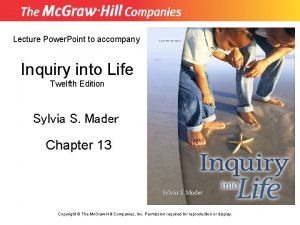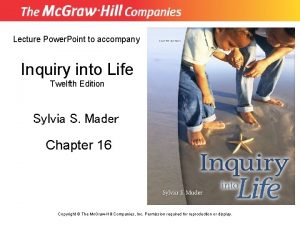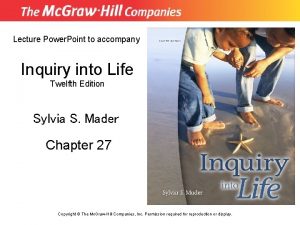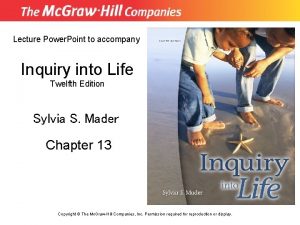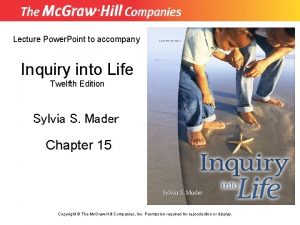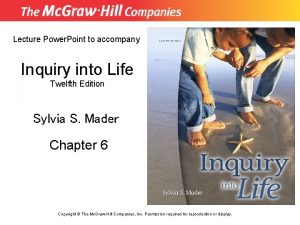Lecture Power Point to accompany Inquiry into Life

























































- Slides: 57

Lecture Power. Point to accompany Inquiry into Life Twelfth Edition Sylvia S. Mader Chapter 22 Copyright © The Mc. Graw-Hill Companies, Inc. Permission required for reproduction or display.

22. 1 Principles of Animal Development • Fertilization • Sperm squeezes through follicle cells • Sperm releases acrosomal enzymes so it can penetrate the zona pellucida • Sperm cell membrane fuses with egg cell membrane • Sperm enters egg, nucleus is released • Egg nucleus and sperm nucleus fuse forming a zygote

Fertilization

22. 1 Principles of Animal Development • Early Stages of Animal Development – Cleavage: first mitotic divisions resulting in a multicellular embryo • Cell divisions without growth in size • Increases number of cells but not the total volume of cytoplasm – Cleavage Divisions • Divisions of zygote are equal • Forms a multicellular stage called a morula (ball of cells) • The next stage is the Blastula (a hollow ball of cells) – The fluid-filled cavity is called a blastocoel

Lancelet Early Development

22. 1 Principles of Animal Development • Early Stages of Animal Development – All vertebrates have a blastula stage, but the appearance may be different – Human blastulas resemble chick blastulas even though we have little yolk

22. 1 Principles of Animal Development • Tissue stages of Development – Gastrulation: The invagination of cells into the blastocoel • Cells migrate to specific destinations • Form distinct cell layers- “germ” layers • Pore created by invagination is the blastopore – Early Gastrula has two layers of cells • Ectoderm- outer layer of cells • Endoderm- inner layer of cells – Lines the archenteron – Late gastrula- has three layers of cells • A middle mesoderm layer is formed

Comparative Development of Mesoderm


22. 1 Principles of Animal Development • Organ Stages of Development – Mesodermal cells alongitudinal axis of the embryo form the notochord • Notochord persists in the lancelet but is replaced by the vertebral column in vertebrates – The nervous system develops from the ectoderm • Neural plate stage-thickening of ectoderm above notochord forms neural plate • Neural folds form moving upward and joining to form a neural tube – Anterior end becomes the brain, the rest becomes spinal cord • Neural crest cells form where tube pinches off from ectoderm– Cells migrate to contribute to skin, muscles, adrenal medulla, ganglia

Development of Neural Tube and Coelom in a Frog Embryo

Vertebrate Embryo (Cross Section)

22. 1 Principles of Animal Development • Processes of Animal Development – Cellular Differentiation • Cells become specialized in structure and function – Morphogenesis • Produces the shape and form of the body – Pattern Formation • How tissues and organs are arranged in the body

22. 1 Principles of Animal Development • Processes of Animal Development – Cellular Differentiation • Due to differential gene expression • Frogs: egg cytoplasm is different in different regions – Gray crescent is visible after fertilization – Egg has polarity- both a dorsal/ventral and anterior/posterior axis – A classic experiment » If egg is divided so both halves get gray crescent, then two complete tadpoles develop » If egg is divided so only half gets gray crescent, then that half develops into a tadpole and the other half stops developing

Experimental Determination of Cytoplasmic Influence on Development

22. 1 Principles of Animal Development • Processes of Animal Development – Cellular Differentiation Continued • Cytoplasmic Segregation – Frog experiment shows egg contains substances called maternal determinants- influence development – Parceling out of maternal determinants (like the gray crescent) during mitosis – Determines how cells of morula will develop – Specialization of cells is influenced by maternal determinants and signals from surrounding cells • Induction – Ability of one embryonic tissue to influence another by chemical signals

22. 1 Principles of Animal Development • Processes of Animal Development – Cellular Differentiation Continued • Dorsal blastopore lip in the frog is the primary organizer – Contains gray crescent – Cells closest to dorsal lip become endoderm, those farthest become ectoderm, those in the middle become mesoderm – Location of the gray crescent indicates the dorsal surface » Mesoderm here forms the notochord » Notochord induces ectoderm to become the neural plate • Another Example of Induction – Vertebrate eye- optic vesicle induces overlying ectoderm to become the lens – Lens then induces the optic vesicle to form retina

22. 1 Principles of Animal Development • Processes of Animal Development – Morphogenesis • Processes by which specific body plan develops • Morphogen genes- determine relationship of individual parts – Some genes control which end becomes the head and which the tail » These genes code for proteins in a morphogen gradient » Cells at one end have high levels, at the other end they have low levels – Other morphogen genes determine how many segments the body will have – Determines shape of organism

22. 1 Principles of Animal Development • Processes of Animal Development – Morphogenesis Continued • Sequential sets of master genes code for morphogen gradients that activate the next set of master genes, etc. • Homeotic genes-control the organization of differentiated cells into 3 dimensional structures like wings, legs, etc. – All share a sequence of nucleotides called a homeobox » Codes for a sequence of 60 amino acids called a homeodomain » Homeodomain protein binds to DNA and determines which genes are turned on – Homeodomain protein from one homeotic gene binds to the next homeotic gene and turns it on, etc.

Morphogen Gradients in the Fruit Fly

22. 1 Principles of Animal Development • Morphogenesis Continued – Homeotic genes of many different organisms contain the same homeodomain- indicates this sequence originated early in evolutionary history – Apoptosis-plays role in morphogenesis • Hands and feet of humans are shaped by apoptosis • Cell receives a death signal – An inhibiting protein becomes inactivated – Cell-death cascade proceeds – Enzymes destroy cell

Pattern Formation in Drosophila

22. 2 Human Embryonic and Fetal Development • Human Development – From conception to birth is approximately nine months – Embryonic Development- Months 1 and 2 • Development of all organ systems – Fetal Development- Months 3 -9 • Refinement of organ systems

Extraembryonic Membranes

22. 2 Human Embryonic and Fetal Development • Extraembryonic Membranes – In the Chick • • Chorion: lies next to the shell and functions in gas exchange Amnion: contains amniotic fluid which bathes embryo Allantois: collects nitrogenous wastes Yolk sac: surrounds yolk which provides nourishment – Humans • • Chorion: develops into the fetal side of the placenta Yolk sac: the earliest site of blood cell formation Allantoic vessels: become the umbilical vessels Amnion: contains the amniotic fluid

22. 2 Human Embryonic and Fetal Development • Embryonic Development - The First Week – Fertilization occurs within the first 1/3 of the oviduct – Zygote undergoes the first cleavage divisions as it migrates through the oviduct toward the uterus – After about three days it is in the morula stage • Morula enters the uterus • At day five it has become a blastocyst – Outer layer of trophoblast cells becomes the chorion – The inner cell mass becomes the embryo

Human Development Before Implantation

22. 2 Human Embryonic and Fetal Development • Embryonic Development - The Second Week – Implantation- trophoblast cells secrete digestive enzymes to burrow into the endometrium – Trophoblast cells begin to secrete human chorionic gonadotropin – Inner cell mass detaches itself from the trophoblast – Amnion and yolk sac develop – Gastrulation occurs- inner cell mass now becomes the flattened embryonic disk • At this stage ectoderm and endoderm differentiate – Embryonic disk elongates to form primitive streak and mesoderm develops

Human Embryonic Development

22. 2 Human Embryonic and Fetal Development • Embryonic Development • The Third Week – The nervous system becomes visually evident – Development of the heart begins • The Fourth and Fifth Weeks – The body stalk (mesoderm) connects the tail end of the embryo with the chorion • Allantois is contained within this stalk – Limb buds appear – Sense organs are distinguishable

Human Embryonic Development

Human Embryo at the Beginning of the Fifth Week

22. 2 Human Embryonic and Fetal Development • Embryonic Development • The Sixth Through Eighth Weeks • The embryo becomes recognizable as human • Nervous system continues to develop – Reflexes are present • All organ systems are now established

22. 2 Human Embryonic and Fetal Development • Fetal Development – The Third and Fourth Months • The head is large, nose is flat, eyes are far apart • Epidermal structures develop – Eyelashes, hair on head, eyebrows, fingernails, and nipples • Cartilage begins to be replaced by bones • Sex of the individual may be determined • In the fourth month, the heartbeat can be heard

Three to Four Month Old Fetus

22. 2 Human Embryonic and Fetal Development • Fetal Development – The Fifth Through Seventh Months • The mother begins to feel movement • Fetal skin is covered by fine hair called lanugo • The skin is also covered with a thick, cheesy coating called the vernix caseosa • Eyelids are open • Survival is now possible if birth occurs prematurely

22. 2 Human Embryonic and Fetal Development • Fetal Development – Features of Fetal Circulation • A fetus does not use its lungs for gas exchange • Blood entering the right atrium is shunted through the left atrium through the oval opening (foramen ovale) • Any blood that enters the right ventricle ends up being shunted into the aorta by way of the arterial duct (ductus arteriosus) • Blood in the aorta is distributed to iliac arteries leading to the placenta

22. 2 Human Embryonic and Fetal Development • Fetal Development – Features of Fetal Circulation continued • Exchange of gases and nutrients between the fetus and mother occur in the placenta • Blood leaves the placenta via the umbilical vein • Blood enters the fetal liver and joins the venous duct which merges with the inferior vena cava • The inferior vena cava returns blood to the heart

Fetal Circulation and the Placenta

22. 2 Human Embryonic and Fetal Development • Fetal Development – Features of Fetal Circulation continued • At birth blood in the left atrium should cause a flap to close off oval opening • Arterial duct closes as endothelial cells proliferate. Remains of the arterial duct and umbilical vessels are converted to connective tissue • The most common cardiac defects in newborns is that the oval opening fails to close. – Failure to close can usually be corrected by surgery

22. 2 Human Embryonic and Fetal Development • Fetal Development – Structure and Function of the Placenta • The placenta is attached to the uterine wall by the allantois and chorionic villi • Placenta is fully formed by the tenth week – Produces progesterone and estrogen – Functions in gas, nutrient, and waste exchange between the fetal and maternal circulatory systems – Fetal and maternal blood do not mix

Anatomy of the Placenta in a Fetus at Six to Seven Months

22. 2 Human Embryonic and Fetal Development • Fetal Development – Structure and Function of the Placenta • The umbilical cord functions to take fetal blood to and from the placenta. • Harmful substances (ex: alcohol, some medications) can cross the placenta and cause irreversible birth defects

22. 2 Human Embryonic and Fetal Development • Birth – Contractions occur throughout the third trimester and become stronger and more frequent toward the end of pregnancy. – A positive feedback mechanism is involved. • Stretching of the uterus causes oxytocin release – Oxytocin causes further contractions which causes the uterus to be stretched further. – More oxytocin is then released

22. 2 Human Embryonic and Fetal Development • Birth – Events That Occur Shortly Before Birth • Strong uterine contractions occur about every five minutes • The “water breaks”, meaning the amnion has ruptured and the amniotic fluid is released • A mucus plug (from the cervix) is expelled – The plug prevents bacteria and sperm from entering the vagina during pregnancy

Three Stages of Parturition (birth)

22. 2 Human Embryonic and Fetal Development • Female Breast and Lactation – Each contains 15 -25 lobules • Lobule has a milk duct which branches from the nipple into numerous smaller ducts that terminate in alveoli • During pregnancy the number of ducts and alveoli increase • Prolactin stimulates milk synthesis – Inhibited by estrogen and progesterone during pregnancy – When placenta is delivered, the anterior pituitary produces prolactin • First secretions are colostrum which is rich in protein and antibodies – Suckling stimulus-causes oxytocin release • Oxytocin causes milk let-down into the ducts

Female Breast Anatomy

22. 2 Human Embryonic and Fetal Development • Benefits of Breast Feeding – Breast milk contains antibodies – Breast-fed babies are less likely to develop stomach and intestinal illnesses in the first 13 weeks of life – Suckling by the baby helps return the uterus to normal size – Breast-feeding burns calories helping the mother to return to her normal weight

22. 3 Human Development After Birth • Development continues throughout the stages of life. • • Infancy Childhood Adolescence Adulthood • Gerontology is the study of aging.

22. 3 Human Development After Birth • Hypotheses About Aging – Genetic in Origin • Cells divide a specific number of times – This is species specific • Some cell lines become nonfunctional before the maximum number of divisions occurs – Mutations may accumulate and affect function • Children of long-lived parents tend to live longer than children of shorter-lived parents

22. 3 Human Development After Birth • Hypotheses About Aging – Whole-Body Process • Decline in hormonal systems affect many different organs • Could also be due to a change in a specific tissue type that affects many organs – Cross-linkages in collagen lead to stiffness, decreased elasticity – Extrinsic Factors • Could be that we view as aging is actually the result of poor life choices in nutrition, habits • Sensible diet and exercise may prevent many signs of aging

22. 3 Human Development After Birth • Effect of Age on Body Systems – Skin • • Thinner, less elastic, less subcutaneous fat Causes wrinkles, decreased insulation Number of oil glands reduced, skin is dry Pigmented blotches may appear

22. 3 Human Development After Birth • Effect of Age on Body Systems – Processing and Transport • Cardiovascular disorders are the leading cause of death – Heart shrinks because of reduction in cardiac muscle cell size – Arteries become more rigid; plaque buildup may narrow lumen of vessels – Blood pressure increases with age

22. 3 Human Development After Birth • Effect of Age on Body Systems – Processing and Transport • Cardiovascular disorders are the leading cause of death – Blood flow to the liver is reduced, and the liver does not metabolize drugs as efficiently. » Smaller doses of medications are needed – Blood supply to the kidneys is also reduced » Salt and water balance are difficult to maintain » The elderly dehydrate easier than young people

22. 3 Human Development After Birth • Effect of Age on Body Systems – Integration and Coordination • • • Brain and muscle cells do not replace lost cells Few neurons in cerebral cortex are lost. Cognitive functions are not affected in normal aging Short-term memory skills may decrease If neurons do die, may be due to decreased oxygen availability and not from aging • Loss of skeletal muscle mass may prevented by exercise • Osteoporosis may be prevented by calcium intake and exercise

22. 3 Human Development After Birth • Effect of Age on Body Systems – The Reproductive System • Females undergo menopause • Males produce less androgens – Still produce sperm until death • Females tend to live longer than males
 Upper limb venous anatomy
Upper limb venous anatomy Hebrews 6:9-12 sermon
Hebrews 6:9-12 sermon Accompany chapter 1
Accompany chapter 1 Printers create objects such as prototypes and models.
Printers create objects such as prototypes and models. 01:640:244 lecture notes - lecture 15: plat, idah, farad
01:640:244 lecture notes - lecture 15: plat, idah, farad Draw power triangle
Draw power triangle Power bi training powerpoint
Power bi training powerpoint Point point power
Point point power The detectives need more time to inquire about the case
The detectives need more time to inquire about the case Power system dynamics and stability lecture notes
Power system dynamics and stability lecture notes Zline 667-36
Zline 667-36 Power semiconductor devices lecture notes
Power semiconductor devices lecture notes Switch mode power supply lecture notes
Switch mode power supply lecture notes Power system dynamics and stability lecture notes
Power system dynamics and stability lecture notes Things fall apart customs
Things fall apart customs Life lecture meaning
Life lecture meaning Drawing on the power of jesus christ nelson
Drawing on the power of jesus christ nelson Invisibility flight the power to split into multiple bodies
Invisibility flight the power to split into multiple bodies Why did japan turn itself into an imperialist power?
Why did japan turn itself into an imperialist power? A high point of land extending into water
A high point of land extending into water The point that divides a segment into two
The point that divides a segment into two Solar power satellites and microwave power transmission
Solar power satellites and microwave power transmission Actual power and potential power
Actual power and potential power Flex28024a
Flex28024a Unit of dispersive power of grating
Unit of dispersive power of grating Power of a power property
Power of a power property General power rule vs power rule
General power rule vs power rule Power angle curve in power system stability
Power angle curve in power system stability Power delivered vs power absorbed
Power delivered vs power absorbed People come in your life for a reason
People come in your life for a reason Life is divided into three terms
Life is divided into three terms Evangelio del domingo en power point
Evangelio del domingo en power point Aplausos sonido
Aplausos sonido La boutique del power point
La boutique del power point Powerpoint tennis
Powerpoint tennis Power point turing complete
Power point turing complete Power point sul riciclo in inglese
Power point sul riciclo in inglese Alat peraga geometri sma
Alat peraga geometri sma Pelajaran sekolah sabat powerpoint 2021
Pelajaran sekolah sabat powerpoint 2021 Laboutiquedelpowerpoint x
Laboutiquedelpowerpoint x La boutique del power point
La boutique del power point La boutique del power point
La boutique del power point La boutique del powerpoint
La boutique del powerpoint Animasi terima kasih power point bergerak
Animasi terima kasih power point bergerak Decreto 1330 del 25 de julio de 2019
Decreto 1330 del 25 de julio de 2019 Conclusão apresentação power point
Conclusão apresentação power point Ejemplo de un portafolio
Ejemplo de un portafolio Icon pada toolbar untuk format penomoran adalah
Icon pada toolbar untuk format penomoran adalah Formula potencia electrica
Formula potencia electrica Microsoft powerpoint disadvantages
Microsoft powerpoint disadvantages Ventajas de power point
Ventajas de power point Presentazione power point tesina
Presentazione power point tesina La boutique del power point x
La boutique del power point x Contoh ppt rpp
Contoh ppt rpp Power point fisica
Power point fisica Power point
Power point Concentrese en power point
Concentrese en power point Bosquejos en power point
Bosquejos en power point








